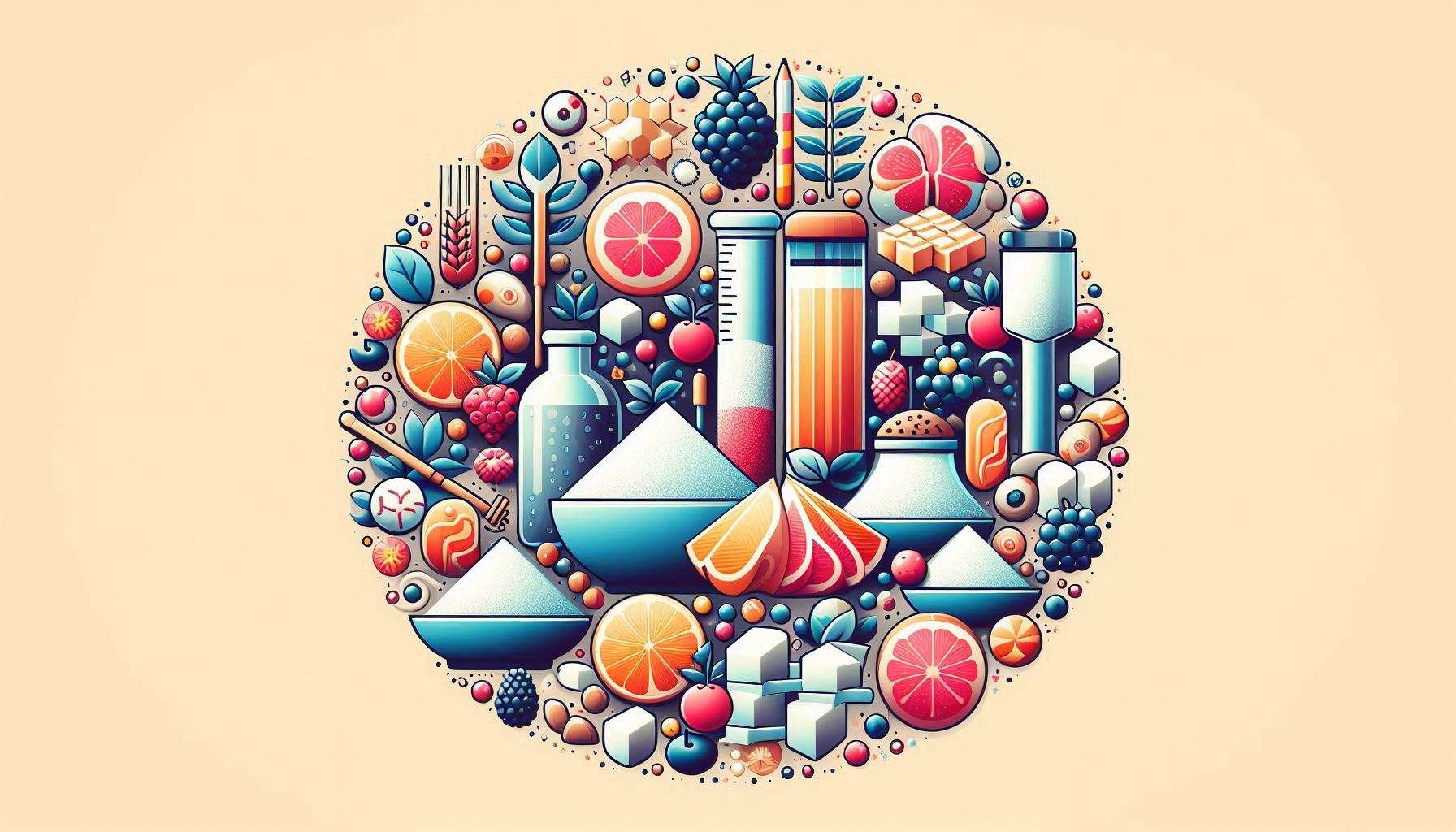The Truth About Sugar: How to Cut Down on Added Sugars for Better Health is a crucial topic that has gained significant attention in recent years. Consuming high amounts of added sugars has become a major health concern, leading to an increased risk of obesity, diabetes, and heart disease. In this article, we will delve into the world of sugar, exploring the truth about its effects on our health and providing valuable insights on how to cut down on added sugars for a healthier lifestyle.
The average person consumes a staggering amount of sugar every day, often without even realizing it. Sugary drinks, processed foods, and baked goods are just a few examples of how sugar sneaks its way into our diets. The American Heart Association recommends that women consume no more than 25 grams (6 teaspoons) of added sugars per day, while men should limit their intake to no more than 36 grams (9 teaspoons) per day. However, the reality is that most people far exceed these guidelines, putting their health at risk. To make matters worse, sugar is often disguised in food products under different names, making it challenging to track our sugar intake.
The consequences of excessive sugar consumption are severe. Added sugars have been linked to a higher risk of obesity, type 2 diabetes, and heart disease. Sugar can also have a negative impact on our mental health, leading to mood swings, anxiety, and depression. Furthermore, a diet high in sugar can lead to an increased risk of certain cancers, such as pancreatic cancer. The good news is that it’s never too late to make a change and cut down on added sugars. By being mindful of sugar intake and making a few simple changes to our diets, we can significantly reduce the risk of these health problems and improve our overall well-being.
Understanding the Different Types of Sugar: Natural vs. Added Sugars
When discussing Understanding the Different Types of Sugar, the first major distinction is between natural sugars and added sugars. Natural sugars occur naturally in whole foods such as fruits (fructose) and dairy (lactose). These come packaged with fiber, vitamins, and minerals, slowing absorption and preventing sudden spikes in blood glucose. Added sugars, on the other hand, include syrups, cane sugar, and concentrated juices—ingredients you’ll often find in processed foods like sodas, pastries, and flavored yogurts. According to the American Heart Association, adults should limit added sugars to no more than 6 to 9 teaspoons per day. Internal resources such as our Healthy Eating Basics page offer tips on reducing added sugar consumption.
Monosaccharides vs. Disaccharides
Monosaccharides are the simplest form of sugar—single molecules that include glucose, fructose, and galactose. Glucose is often called “blood sugar” since it circulates in your bloodstream and fuels your cells. Fructose, found in fruits, is sweeter than glucose and metabolized primarily by the liver. Galactose, a component of lactose, rarely appears alone in nature. Disaccharides, however, form when two monosaccharides join. Common disaccharides include sucrose (table sugar, made of glucose + fructose), lactose (dairy sugar, glucose + galactose), and maltose (grain sugar, glucose + glucose). When you consume disaccharides, enzymes in your digestive tract break them down into monosaccharides for absorption. For more on how these simple and double sugars affect your body, check our Nutrition & Digestion Guide.
Common Types of Sugar Used in Cooking and Baking
-
Granulated White Sugar (Sucrose): The most familiar form of table sugar. Derived from sugarcane or sugar beets, it has a 1:1 ratio of glucose to fructose. Used for sweetening beverages, baking cakes, and making syrups.
-
Brown Sugar: White sugar with added molasses. Light brown sugar contains about 3.5% molasses, while dark brown sugar has roughly 6.5%. Provides moisture and a caramel-like flavor to cookies and sauces.
-
Raw Sugar (Turbinado or Demerara): Less refined, retaining some molasses in large crystals. Often used as a topping on oatmeal or for decorative purposes on baked goods.
-
Powdered (Confectioners’) Sugar: Finely ground white sugar mixed with a small amount of cornstarch to prevent caking. Ideal for icings, dusting baked treats, and stabilizing certain frostings.
-
Cane Sugar vs. Beet Sugar: Although both yield sucrose, some people prefer cane sugar due to minimal processing. If you want to explore further, see the USDA’s Sugar Basics.
Understanding the Different Types of Sugar: Specialty Sweeteners
In recent years, numerous specialty sweeteners have gained popularity. These fall into two broad categories: natural alternatives and artificial sweeteners.
Natural Alternatives
Natural Alternatives to refined sugar have gained popularity as people seek healthier sweetening options. Instead of relying on white sugar or high-fructose corn syrup, you can use natural sweeteners that provide beneficial nutrients, lower glycemic impact, and richer flavors. In this guide, we’ll explore five top natural alternatives—honey, maple syrup, agave nectar, coconut sugar, and stevia—and explain how to use them effectively in your favorite recipes.
Honey:
A mix of glucose, fructose, and water, honey carries trace enzymes, antioxidants, and micronutrients. Its glycemic index varies by floral source, often lower than white sugar. Use a small amount to sweeten tea or yogurt.
Honey is one of the oldest Natural Alternatives used for sweetening. Produced by bees from flower nectar, honey contains trace vitamins, minerals, and antioxidants that support immune function. Compared to refined sugar, which is nearly 100% sucrose, honey is roughly 40% fructose and 30% glucose, offering a slightly lower glycemic index (GI) of around 50–58 (depending on the floral source).¹ Use honey in:
-
Tea and Coffee: Substitute 1 tablespoon of honey for 1 tablespoon of sugar.
-
Baking: Reduce total liquid by ¼ cup for every cup of honey used.
-
Dressings and Marinades: Stir in honey for a balanced sweetness in vinaigrettes.
Visit the American Heart Association for guidelines on recommended added sugar intake.
Maple Syrup:
Derived from the sap of maple trees, this syrup is predominantly sucrose, with some minerals like manganese and zinc. Best used sparingly over pancakes or in marinades.
Maple syrup, tapped from maple trees, is another widely praised Natural Alternative. It primarily consists of sucrose (about 60%), with smaller amounts of glucose and fructose. Unlike refined sugar, maple syrup delivers minerals like manganese, zinc, and calcium. Its GI hovers around 54, making it a moderate-impact sweetener.² Try maple syrup in:
-
Pancakes and Waffles: Drizzle pure maple syrup instead of pancake syrup.
-
Oatmeal & Yogurt: Stir in 1–2 teaspoons to enhance flavor.
-
Roasted Vegetables: Combine maple syrup with olive oil and seasoning for a caramelized glaze.
For more details on pure maple syrup, check out the New York State Maple Producers Association.
Agave Nectar:
Extracted from agave plants, agave nectar is high in fructose—about 90%—making it sweeter than regular sugar. Because of its high fructose content, limit use to avoid potential insulin resistance issues.
Agave nectar is extracted from the agave plant’s sap. It is sweeter than table sugar and has a low GI of approximately 11–19.³ However, agave is very high in fructose (about 70–90%), so use it sparingly. Opt for agave nectar in:
-
Smoothies: Add 1 teaspoon of agave nectar to mask bitter greens.
-
Dressing & Sauces: Create a creamy, sweet consistency in homemade dressings.
-
Baking: Replace ¾ cup of sugar with ½ cup of agave nectar; reduce other liquids by 3 tablespoons
Coconut Sugar:
Made from the sap of coconut palm flower buds. Contains inulin, a fiber that may slow glucose absorption slightly. Despite marketing claims, coconut sugar’s calorie and carbohydrate content are similar to granulated sugar.
Natural Alternatives include coconut sugar, made by evaporating coconut palm sap. Coconut sugar holds trace amounts of iron, zinc, calcium, and potassium, plus inulin fiber, which may slow glucose absorption.⁴ Its GI is around 35, lower than refined sugar. Use coconut sugar in:
-
Baking: Substitute 1:1 for white or brown sugar in cookies, muffins, and cakes.
-
Coffee & Tea: Stir in 1–2 teaspoons to sweeten beverages.
-
Savory Recipes: Sprinkle coconut sugar in chili or barbecue rubs for a hint of sweetness.
Artificial & Low-Calorie Sweeteners
-
Stevia: A plant-derived, zero-calorie sweetener. Stevia extracts can be up to 300 times sweeter than sugar. Best for diabetics or those on calorie-restricted diets. Brands like Truvia offer stevia-based products.
-
Erythritol & Xylitol (Sugar Alcohols): Naturally occurring in fruits, these polyols provide sweetness with fewer calories. Erythritol has almost zero calories and a 0 glycemic index, while xylitol has about 40% fewer calories than sugar. Use in baking if tolerated—xylitol can cause digestive upset in some people.
-
Aspartame, Sucralose, Saccharin: Synthetic sweeteners that offer high-intensity sweetness with minimal or no calories. Each carries its own taste profile and safety considerations. For up-to-date research, see the FDA’s Sweeteners Overview.
Health Impacts & How to Read Labels
Stevia: A Zero-Calorie Natural Alternative
Stevia, derived from the leaves of the Stevia rebaudiana plant, is an intensely sweet, zero-calorie Natural Alternative. Its sweetness is 200–300 times greater than sugar, so a little goes a long way. Stevia has a GI of zero and does not raise blood glucose levels.⁵ Incorporate stevia in:
-
Beverages: Use liquid stevia drops or stevia powder to sweeten tea, coffee, and lemonade.
-
Baking: Replace sugar with stevia-based baking blends; follow package instructions for equivalency.
-
Sauces & Jams: Stevia’s heat-stable profile makes it ideal for homemade preserves.
Tips for Using Natural Alternatives Effectively
-
Adjust Liquid Ratios: Many natural sweeteners (honey, maple syrup, agave) contain water. Reduce other liquids (milk, oil) by 3 tablespoons for every ½ cup of liquid sweetener.
-
Flavor Profiles: Each natural sweetener has a distinct taste—honey can be floral, maple syrup has a rich caramel flavor, and agave is more neutral. Choose based on your recipe.
-
Storage: Store honey at room temperature in a sealed jar. Pure maple syrup belongs in the refrigerator after opening to prevent fermentation.
-
Moderation: Although these are Natural Alternatives, they still contribute calories and carbohydrates. Monitor portion sizes to maintain balanced nutrition.
External Resources (DoFollow Links)
By incorporating Natural Alternatives like honey, maple syrup, agave nectar, coconut sugar, and stevia into your daily routine, you can reduce reliance on refined sugar, enjoy added nutrients, and support stable blood sugar levels. Explore our internal guide on Healthy Sweetening Tips to discover recipe ideas and personalized strategies for balanced sweetness.
Understanding the Different Types of Sugar empowers you to make informed choices—whether you’re comparing brown sugar versus white sugar or exploring natural sweeteners like honey and maple syrup. By paying attention to labels, opting for whole-food sources, and moderating intake of added sugars, you can maintain stable blood sugar levels, support your overall health, and still satisfy your sweet tooth. Remember to consult reputable external resources like the American Heart Association and USDA for the latest guidelines, and explore our internal links to further deepen your nutrition knowledge.



zivkeq
qlgosy
https://t.me/pt1win/118
https://t.me/s/iGaming_live/4662
https://t.me/iGaming_live/4629
https://t.me/reyting_topcazino/13
https://t.me/s/reyting_topcazino/27
https://t.me/of_1xbet/609
https://t.me/s/ef_beef
https://t.me/officials_pokerdom/3314
https://t.me/s/RejtingTopKazino
https://t.me/s/RejtingTopKazino